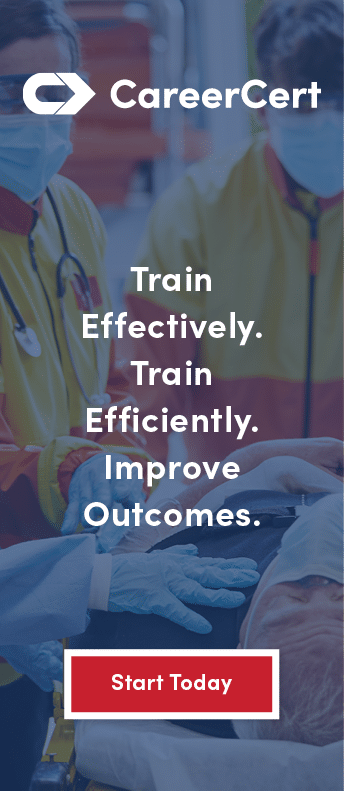Breaking Down Patient Assessment: Performing a Comprehensive Secondary Assessment
 As an EMS instructor, one of the biggest challenges I face when working with new students is finding creative ways to teach how to perform a patient assessment. This is because there are aspects that can be easier to learn than others due to the fact that they never change. For instance, students learn fairly early on to put on proper BSI and to ask if the scene is safe. If you miss these in the classroom you will get a critical fail. If you are in the real world and you miss them, it may cost you more than a grade. Through repetition, students will retain most of the knowledge required to get through the primary assessment: scene size-up, general impression, and primary survey. After that, all they need to do is make a transport determination. So then, once all immediate life threats have been identified and mitigated and a destination has been picked out… what happens next?
As an EMS instructor, one of the biggest challenges I face when working with new students is finding creative ways to teach how to perform a patient assessment. This is because there are aspects that can be easier to learn than others due to the fact that they never change. For instance, students learn fairly early on to put on proper BSI and to ask if the scene is safe. If you miss these in the classroom you will get a critical fail. If you are in the real world and you miss them, it may cost you more than a grade. Through repetition, students will retain most of the knowledge required to get through the primary assessment: scene size-up, general impression, and primary survey. After that, all they need to do is make a transport determination. So then, once all immediate life threats have been identified and mitigated and a destination has been picked out… what happens next?
The secondary assessment of course! However, this is the point where students generally begin to flounder. But it isn’t just our fresh-faced EMT and paramedic students who experience issues with the secondary assessment. Countless other prehospital providers struggle to provide a thorough secondary, delaying or hindering treatment further down the continuum.
In the first part of this series, we looked at the primary survey, the first step in performing an assessment on any patient encountered in the prehospital setting. As I stated in the previous article, the primary assessment is meant to do one thing and one thing only: detect and correct immediate or imminent life threats. While this is an incredibly important factor in patient care, it is not the ONLY factor. Once threats to the patient’s ability to maintain effective perfusion have been mitigated, our focus should then turn to obtaining vital signs, understanding the patient’s medical history, addressing any secondary complaints, providing ongoing interventions, and reassessing said interventions and information obtained during the primary assessment. This brings us to the comprehensive secondary assessment. Here we will look at all of the aspects involved in this portion of the patient care experience.
Vital Signs
In the classroom (and, to some extent, the field), we focus heavily on visual and tactile diagnostics in order to determine whether our patient is “sick” or “not sick,” and thus emergent or non-emergent. Logic dictates that we can do this without the aid of manual diagnostic tools such as the BP cuff or pulse oximeter. For the most part, this is correct. A clinician should be able to make a determination as to whether their patient is stable or unstable during the primary assessment. That being said, obtaining vital signs at the beginning of the secondary assessment is crucial for 2 reasons. First, it gives you a baseline from which to assess the effectiveness of your interventions. And second, these baseline vitals are crucial in helping to determine your primary and differential diagnosis. Moreover, multiple diagnostic tests should be conducted so as to ensure a succinct and accurate field diagnosis. For instance, take an 80-year-old male who was found with an altered mental status and a BGL of 62. If all we went off of was the patient’s blood glucose levels, we might assume this is a diabetic patient who is experiencing an episode of hypoglycemia. However, if we were to find that the patient was hypotensive, tachypneic, tachycardic, hyperthermic, and hypoglycemic with a poor skin condition, then we would more likely assume that the patient is in septic shock. At a minimum, the clinician should obtain blood pressure, SPo2, BGL, pulse rate, respiratory rate, temperature, and pain level.
The 3 Ps
Vital signs, skills that students learn fairly early on in class, are easy enough. As we move further into the secondary assessment, more critical thinking skills are needed. Many clinicians struggle greatly with where exactly to start. For the sake of being easy, I always say start at what the patient’s condition was BEFORE the complaint began and then move on from there. That is to say, begin in the past, assess the present, and then the patient themselves (the 3 ps).
Past
This primarily includes the SAMPLE history acronym, which stands for symptoms, allergies, medications, past medical history, last oral intake, and events preceding. This information is generally focused on the patient’s life prior to the signs or symptoms we identify in “S.” Typically, we begin with the chief complaint. We may ask the patient something along the lines of “what brings us out today,” or “if you had to narrow down your complaint to one issue, what might it be?”
Next, we can ascertain whether the patient has any allergies to medications or other substances (it is important to differentiate between the 2), what medications they have been prescribed by the doctor (do not just ask if they are taking medications as they may not be compliant; I want to know what they are supposed to be taking, and then I want to know if they actually are), past PERTINENT medical history (we do NOT need to know that they had their wisdom teeth out 50 years ago), last oral intake (the last time they had anything to eat or drink), and the events leading up to the beginning of the complaint.
Present
The present mnemonic that we typically use is the OPQRST, which stands for onset, provocation, quality, radiate, severity, and time. It should be noted, however, that this is generally best suited for medically induced pain, such as chest, abdominal, back, etc. It would typically not be appropriate for issues such as seizures, syncope, stroke, or the like. That being said, a neurological exam (BEFAST, CPSS, MEND) could be substituted here for the OPQRST so as to give the clinician a present baseline to work from. The OPQRST would start by picking up where the SAMPLE left off. What were you doing at the onset of symptoms? Does anything make the pain better or worse? What region is the pain in and does it radiate? On a scale of 1 to 10, with 10 being the worst and 1 being none at all, how would you rate your pain? And lastly, what time did the pain begin?
Patient
Now we examine our patient. This can actually be broken down into 2 parts: the head-to-toe exam and the system-specific assessment. While many pre-hospital clinicians may question the idea of a head-to-toe exam on a medical patient, think about any time you have even been to the doctor’s office. Nine times out of 10 he is going to do an abbreviated physical exam, if for no other reason than to ensure that there isn’t any major cause of concern. Prehospital clinicians should be doing the same. In class, we learned all about physical diagnostic techniques such as percussion, palpation, and auscultation. How many of us carried that over into the field?
Performing a head-to-toe exam forces the provider to put their hands on their patient, and you may be surprised at what you find. For the sake of brevity, I will include the head to toe at the end of the article, but suffice to say that, in written form, it takes much longer to read than to do. The system-specific assessment looks at the system that is primarily affected by the complaint. For instance, if my patient is exhibiting signs or symptoms of a seizure, then a neurological exam might be appropriate to determine whether the patient is improving during their postictal period or if they are lapsing into status epilepticus. Or say you have a patient experiencing chest pain and you are trying to determine if you are dealing with angina or an AMI; you would focus your assessment on symptom improvement with rest or nitro. You may even take it further and discuss family history (any patient who tells me they had a parent die of a heart attack before the age of 50 sets off an automatic red warning light in my mind). Simply put, the system-specific exam should concentrate on aspects of that system that could be affected by the complaint. Additionally, you should interview the patient about factors such as smoking, drug/alcohol use, sedentary lifestyle, family history, safety concerns, environmental factors, etc.
Interventions
I do not plan on going over interventions in detail as the topic of the article is patient assessment, not patient interventions. That being said, it does bear mentioning that interventions are driven exclusively on either the primary or secondary assessment. “Of course,” you say out loud to yourself, “nobody in their right mind performs an intervention without assessing their patient.” To that I say, “Oh yeah?” As someone who has proctored countless NREMT psychomotor exams, I can tell you firsthand about students walking into a scenario and slapping a patient on a non-rebreather at 15 liters per minute before they even asked about ABCs. And before you paramedics begin saying, “Well those are EMT students, not paramedic students,” know that we aren’t any less guilty. During the medical assessment scenarios, I would keep track of how many students would casually remark “IV, O2, Monitor” before even bothering to begin their assessment. That carries over into the field. Now, of course there are extenuating circumstances. Many EMS services mandate that every ALS patient receive a 12-Lead and IV, regardless of the nature of the complaint. But it is exactly that cookie-cutter, follow-the-line mentality that breeds complacency and destroys a clinician’s ability to think critically.
Bottom line: Assess your patient before ordering interventions that may not benefit them or might possibly skew later diagnostics.
Reassessment
At this point we have gotten pretty much to the end, have we not? We obtained vitals, performed a thorough assessment, and ordered sufficient interventions based on the results of said assessment. Now we can just sit back, do our chart, and maybe answer some text messages that we missed on the way to the hospital, right? Wrong!
Now we must continue our assessment by reevaluating our initial findings. We go back over the primary assessment, looking for changes in patient status or any new life threats. If we performed an intervention to correct an immediate life threat, is it still working? How does the patient’s history jive with the vitals we obtained? Are the subsequent interventions we initiated effective? What are our vital signs now? Five minutes from now? Ten minutes from now? If your patient can talk, what are they saying? Has their complaint abated, become worse, or not changed at all?
In addition to all of that, we must also prepare our report for the next clinician. This is perhaps one of the most crucial phases of the patient care experience. Your report will set the tone for how the patient is treated in the ER. While we would like to believe that every patient is going to receive the same care regardless of what you say, the truth is that most hospital staff are looking to you to best understand what is going on with the patient. You must effectively convey the needed urgency to the patient’s RN and physician. Think of it as painting a picture. You get to set the stage for what you want the staff at the hospital to see. Are they going to see an “adult male complaining of chest pain”? Or are they going to see “Mr. Davidson, a 49-year-old male coming from his home with had a sudden onset of crushing chest pain while at rest, vitals are BP 160/100 Pulse 104/reg/weak SPo2 99% on 4lpm via NC BGL 101 Temp 98.7 Pain is 9/10 and unrelieved by interventions”? Will they be able to understand that “he has a history of angina and is prescribed nitro, which he took 3 of prior to our arrival with no relief” and “his 12-Lead shows a septal-anterior MI with depression in the high lateral leads”? Will they know that “There is an 18g IV in the left AC, he has received 0.4mg nitro SL x3, 324mg ASA PO, and 100mcg Fentanyl IVP without relief”? What information is needed to light a fire under the staff?
Conclusion
At the conclusion of part I of this article, I stated that medicine is a practice, not a certainty. Nothing illustrates this more than the secondary assessment. Unlike its primary counterpart, which begs for the utilization of the step-by-step process, the secondary assessment is more fluid, able to be moved and shaped depending on the patient’s complaint, condition, and presentation. While it can be more challenging, it also allows for a much more in-depth understanding of the patient complaint and not only helps us know how to treat them but also ensures that precious time isn’t lost as they move further down along the healthcare continuum.
Prehospital clinicians should remember that a comprehensive assessment involves the ability to marry the rigidity of the primary with the flexibility of the secondary. Critical thinking, a skill that isn’t just practical but is required for our job, is needed to thoroughly investigate our patient’s chief complaint. When they are comfortable with its tenets, clinicians can become empowered by the ability and freedom to fully assess their patients, making the best choice in their plan of care based on accurate and complete information.
Head-to-Toe Assessment
Head
- Orientation questions
- Facial symmetry (both sides of the face moving symmetrically)
- Speech (clear or slurred)
- Headache or dizziness
- Changes in your vision recently
- Pain or swelling in mouth or throat
Skin
- Color/temp/condition
- Flushed vs pale, dry vs diaphoretic, rashes.
Nose
- Note bleeding or drainage
Eyes
- Color of sclera
- Pupil size
- Light reactivity
Mouth
- Color and level of hydration of mucus membranes
- Size of tongue
- Symmetrical movement of tongue and throat
Neck
- Inspect for rashes, swelling, asymmetry
- Pain in neck or problems swallowing
Chest
- Auscultate chest, back first then front, working from your left to right; note also any tenderness when you place your stethoscope
- Always compare air entry side to side
- Does it hurt to take a breath
- Short of breath
- Cough
Heart
- Auscultate heart
- Chest pain
Abdomen
- Inspect for obvious asymmetry or masses
- Palpate the abdomen once in all 4 quadrants
- Abdominal pain
- Constipation or diarrhea
- Any black stools
Pelvic
- You don’t need to examine the genital area unless there is an injury to the area, or a pregnant female feels the urge to push
- Any pain or difficulty with urination
Upper Extremities
- Inspect skin for rashes, check both radial pulses at the same time to be efficient, and ensure pulses are not only present, but equal, side to side
- Sensory
- Any weakness, tremor, or complaints of pain
- Any pain, swelling, or weakness of arms or hands
Lower Extremities
- Inspect ankles for rashes or swelling
- Check both posterior tibial pulses at the same time to be efficient and ensure pulses are not only present, but equal, side to side
- Sensory
- Any pain or swelling in your legs or feet
 Andrew R. Ross—MHA, NRP—has worked in the EMS industry as a paramedic for 19 years. He is a lead educator at Careercert and has over a decade of experience in EMS education and management. Andrew currently works full-time as the lead faculty instructor in his local community college’s EMS program. As an education advocate, Andrew recently earned his master’s in healthcare administration from the University of Scranton. He is married and has 2 daughters.
Andrew R. Ross—MHA, NRP—has worked in the EMS industry as a paramedic for 19 years. He is a lead educator at Careercert and has over a decade of experience in EMS education and management. Andrew currently works full-time as the lead faculty instructor in his local community college’s EMS program. As an education advocate, Andrew recently earned his master’s in healthcare administration from the University of Scranton. He is married and has 2 daughters.



